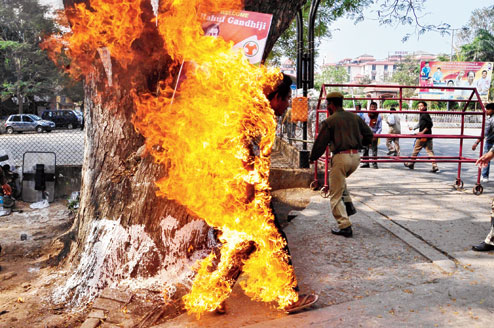The Anatomy Of Self-Immolation
By Rupam Sindhu Kalita
28 February, 2014
Countercurrents.org

He was a small-time carpenter who lived with his wife and daughter in one of the hills that surround Guwahati city. A nondescript man who eked out a living by working hard. On Monday, he decided to join a protest outside the Assam Secretariat in Dispur organized by the Krishak Mukti Sangram Samiti (KMSS). He might have thought that the issues that the KMSS raised were relevant to his own existence as someone living in one of the precariously perched settlements atop a hill. Then this commonplace hill-dweller shocked everyone. He doused himself in petrol, struck a match and lit himself. He swerved, tottered and finally fell as a contingent of security personnel helplessly tried to wrap him in blankets. He died in hospital.
Self-immolation works on a symbolic plane- it is at the same time an act of absolute defiance and helplessness. It is suicide and if we go by Durkheim’s terminology, a mix of fatalistic and altruistic suicide. From Tibetan dissidents and Thích Quàng Đúc, the monk who burnt himself in protest against the South Vietnamese government to Mohammed Bouazizi, a street vendor in Tunis whose death helped rouse the Arab world against depraved regimes, the act of setting oneself on fire has been used as an effective instrument of protest. The self-immolator gives a different angle to the meaning of political protest. He is overcome by thanos, the death wish. He wants people to see the agony of death, how it feels to see a breathing, living human conflagration. Our horror on witnessing the smoldering, fuming and dying human body is transformed to a disgust at the political culture responsible for that terrible sight. The self-immolator reaffirms the agency of the ordinary man and woman in a decadent political culture. He becomes a spectacle. The possessor of an uncanny mode of power.
The hills that flank Guwahati city are dotted with human settlements and dwellers have to fight hostile rainy weather and anti-encroachment drives by the state government. Last Monday, the KMSS gathered outside the state secretariat to protest against the government’s decision to issue land ownership rights to five hundred families who have been living in the forests along the margins and flanks of the city. The Scheduled Tribes and Other Traditional Forest Dwellers (Recognition of Forest Rights) Act, 2006 provides for land ownership rights to all tribal families living in forest areas up to December 13 2005. When the government picked up five hundred families residing on government land till January 28 2001 to distribute land ownership papers without taking into account the provisions of this act, pro-people groups like the KMSS denounced the government decision as arbitrary. They demanded that people living in the forests and wetlands in and around Guwahati too be given rights over their land.
It was a tragic irony that people belonging to indigenous communities like Pranab Boro should come out to the streets to demand land rights. Lost in the labyrinth of capricious dates, government agencies have lost the credibility to decide people’s rights over the land where they have been living for generations. Government sources contend that encroachment over wetlands, low-lying areas and forests have further degraded the fragile ecosystem of the state. But his response is locked in a relationship of irreconcilable contradiction with the gigantic network of dams that are being planned in the Assam-Arunachal border. The flash flood that inundated three lakhs people when waters were released from the dam in Ranganadi tributary flowing into Assam from Arunachal in June 2008 are still fresh in our memory. Now by a quixotic logic, the government is planning a network of 168 mega dams along the Assam-Arunachal border which is also one of the most seismically active zones in the world. Can the state government still be reasonable when it says that land rights are being denied to indigenous communities because of ecological concerns?
How will a government that witnessed the first self-immolation in the state be judged? History will be kinder to Pranab Boro. But it is time that policy-makers take quick decisions to address the just grievances of the people so that no one else is forced to follow in the footsteps of Pranab Boro.
Rupam Sindhu Kalita finished his undergraduate studies in English from St.Stephen’s College, Delhi in 2012 and is currently pursuing a Masters degree from Delhi University in the same discipline. His areas of interest are conflict literature, mythology and Indic studies. He can be contacted at [email protected]
Comments are moderated
